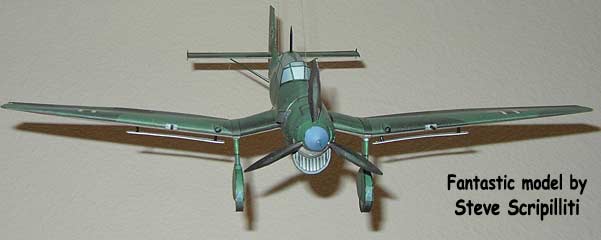

Junkers JU-87 - $$5.50
The Junkers Ju 87 or Stuka (from Sturzkampfflugzeug, "dive bomber") was a two-seat (pilot and rear gunner) German ground-attack aircraft of World War II. Designed by Hermann Pohlmann, the Stuka first flew in 1935 and made its combat début in 1936 as part of the Luftwaffe's Condor Legion during the Spanish Civil War.
Stuka Junkers Ju-87 WWII German Dive Bomber
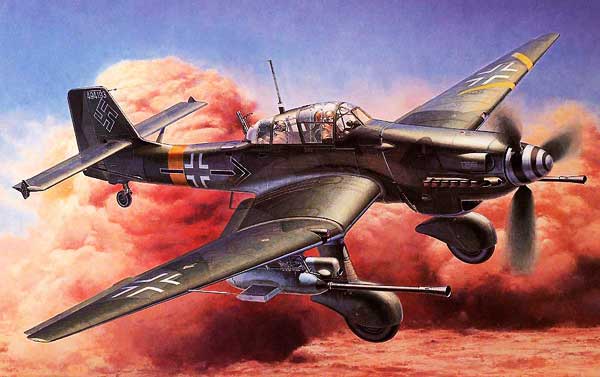
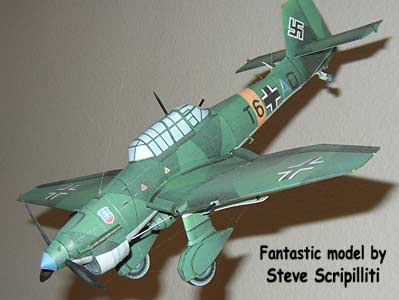
The Ju 87 Stuka Dive bomber, designed by Dipling Hans Pohlmann of Junkers, made its first flight in the early part of 1935. Even today it would still be in any 'top ten' awards for ugliness, but beauty was hardly its business.
To put it as generously as possible, its design was strictly functional, and there is no doubt that this objective was achieved. The initial Ju 87A version, bloodied in the Spanish Civil War from December 1937, was soon superseded by the improved Ju 87B with (though it may not have looked like it) aerodynamic improvements and a substantially more powerful engine. Able to carry up to 2,205 lbs of bombs, according to version, the Ju 87B also was fitted with small sirens near the tops of the main under carriage leg fairing's, to add a devastating and demoralizing scream to the whine of its engine and the whistle of its falling bombs.
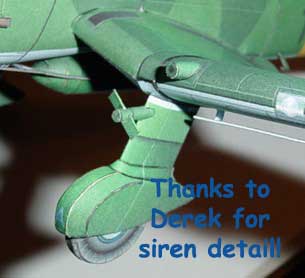
"This is a pretty easy model to build and that surprised me, since on paper (pun intended) it looked a bit problematic. I thought the wing would be the toughest part, but it turned out to be quite easy." Alan A. Wheeler Fairfax, Virginia
May I thank you for this wonderful model - an exceptional piece of 'card engineering'! The cockpit canopy is a work of art in itself! I won't trouble you with a picture as I have built it 'as is' to show the visitors to the upcoming exhibition my model group is having just how good FG models are. The only mod I did do was to add a little prop powered siren (most important on this bird!) to the port u/c leg, and that isn't a criticism because not all the Stuka's had these! Although I remember your first card models from all those years ago with affection I marvel at how far FG has come since then. Long may you continue to delight and excite us!
"Worked on Stuka while watching TV. Fuselage looks good. Possible to get good Stuka shape. Tail section is absolutely ingenious. Wheels and spats look great. Can't wait to make this one a Giant." Dave Caldwell Lexington, KY
"I was able to complete the main fuselage and tail tonight. Very nice. The fit is so good that each succeeding section forces you to correctly shape the fuselage without any guesswork. I started with the cockpit section and worked my way forward first and then to the tail after that. Seemed to work for me."
One more comment. The wings are an engineering gem!.....but,I changed position of the tabs for the center section from the center strip to the wings...just makes it easier for me to get the correct angle. I needed to leave this section open in order to reach into the wings and secure the other tabs...Joe Cangero Islip Terrace, NY.
These are the Stuka Junkers JU-87 models that won the FG Modeling Madness (FGMM) 2010 best in class prize. Thanks to Chris Walas who donated his $20 prize money toward modeling materials for hospitalized vets!! |
|
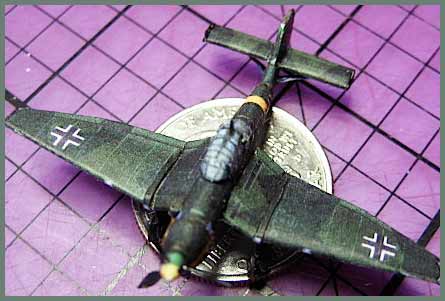 |
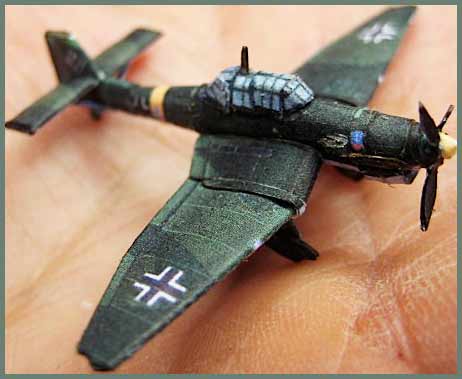 |
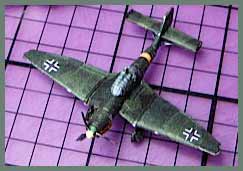 |
I like the challenge of doing smaller models and Ju-87s are a personal favorite. I’ve built the FG Stuka at least a half dozen times now, several in smaller scales. I have to say, this is a tough one for tiny scale; wheel pants, gull wings, tail wing braces and such all add up. It's not tiny tiny. It's about an inch and a half long, but that's small enough! I had originally thought I might brave an attempt at a clear canopy for this one until my eyes made it abundantly clear that I was wisest not to consider it! -Chris |
 |
 |
 |
I just can’t stop building FG Stukas! It’s a fun kit, a little more challenging than a lot of the FG kits due to the wheel pants, gull wing and greenhouse canopy, but it builds into a nice model of the prototype. I darkened mine down as I think the FG colors are a bit bright. The JU-87 is my favorite plane and the FG kit really captures the essence of the real plane.
I also added a shot of my winter scheme version! -Chris |
Junkers Ju 87 STUKA
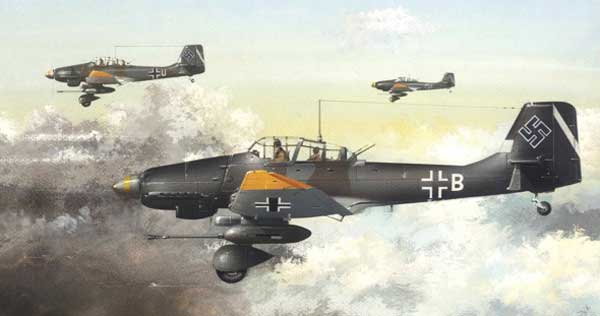
Hailed as the 'supreme weapon' by the German propaganda machine, it did indeed appear to justify this title as it screamed and bombed its way through Poland, Norway, France and the Low Countries during World War 2, against little or no effective fighter opposition. Then, at Dunkirk and in the Battle of Britain, it came up against the Hurricane and Spitfire - and was quickly proved to be clumsy, poorly an-ned and extremely vulnerable. Before the end of August 1940 it had been withdrawn from major operations against Britain, though later, in conditions more favorable to it, it succeeded again in Greece, in Crete and on the Russian Front.
But the 'supreme weapon' myth
had by then been exploded, and even its quite successful use as
a tank-buster (Ju 87D) and anti-shipping aircraft (Ju 87R) was
not enough to restore fully its tarnished reputation.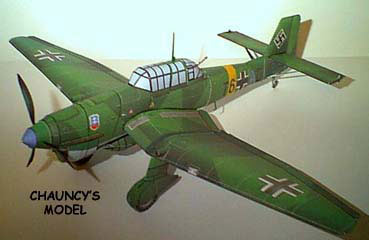
This is one by Chauncy Green for Fiddlers Green and he spent
a lot of time and effort to get it right. We think it's his best
yet. Enjoy! The Ju-87 folder contains two sizes. The larger version
has a wingspan of approx 10 inches.
During the first stages of the Second World War, the Ju 87 proved
a decisive weapon. Abbreviated from Sturzkampfflugzeug (dive bomber),
the word Stuka entered the general vocabulary as a vital component
of the Blitzkrieg, the "lightning war". They fitted a wind whistle
into the LG so it would emit a deathly screeeem as it dove on
its unfortunate target.
The Ju 87 prototype flew in 1935 with a tailplane sporting end
plate vertical surfaces... but the second prototype and all later
aircraft had a single fin and rudder assembly.
Early aircraft
were evaluated in the Spanish Civil War (1936-39). From late 1940
the type was steadily relegated to areas of negligible air opposition.
For lack of a replacement the type remained in production long
after it became obsolete, production totalled 5,709.
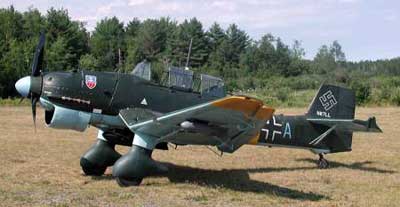 In the mid-1940s the McDonnell Aircraft Company in the
USA built a carrier-based jet fighter which it named the Banshee.
It is a name that might with considerably greater aptness have
been bestowed upon a much less attractive warplane of a decade
earlier; but the Junkers Ju 87 gave rise to a name of its own
that was to have far more terrifying connotations to millions
of Europeans. For the Ju 87 was a Sturzkampfflugzeug, the German
word for dive-bomber, and with deadly effect it was to personify
the sterm 'Stuka' for the rest of its career. Development of the
dive-bomber in Germany was fostered by Ernst Udet, after seeing
a demonstration by the American Curtiss Helldiver in 1933.
In the mid-1940s the McDonnell Aircraft Company in the
USA built a carrier-based jet fighter which it named the Banshee.
It is a name that might with considerably greater aptness have
been bestowed upon a much less attractive warplane of a decade
earlier; but the Junkers Ju 87 gave rise to a name of its own
that was to have far more terrifying connotations to millions
of Europeans. For the Ju 87 was a Sturzkampfflugzeug, the German
word for dive-bomber, and with deadly effect it was to personify
the sterm 'Stuka' for the rest of its career. Development of the
dive-bomber in Germany was fostered by Ernst Udet, after seeing
a demonstration by the American Curtiss Helldiver in 1933.
The Ju 87, designed by Dipl Ing Hans Pohlmann of Junkers, made its first flight in the early pan of 1935. Even today it would still be in any 'top ten' awards for ugliness, but beauty was hardly its business. To put it as generously as possible, its design was strictly functional, and there is no doubt that this objective was achieved. The initial Ju 87A version, blooded in the Spanish Civil War from December 1937, was soon superseded by the improved Ju 87B with (though it may not have looked like it) aerodynamic improvements and a substantially more powerful engine.
Able to carry up to 2,205 lbs of bombs, according to version, the Ju 87B also was fitted with small sirens near the tops of the main under carriage leg fairing's, to add a devastating and demoralizing scream to the whine of its engine and the whistle of its falling bombs. Hailed as the 'supreme weapon' by the German propaganda machine, it did indeed appear to justify this title as it screamed and bombed its way through Poland, Norway, France and the Low Countries during World War 2, against little or no effective fighter opposition.
Then, at Dunkirk and in the Battle of Britain, it came up against the Hurricane and Spitfire - and was quickly proved to be clumsy, poorly an-ned and extremely vulnerable. Before the end of August 1940 it had been withdrawn from major operations against Britain, though later, in conditions more favorable to it, it succeeded again in Greece, in Crete and on the Russian Front. But the 'supreme weapon' myth had by then been exploded, and even its quite successful use as a tank-buster (Ju 87D) and anti-shipping aircraft (Ju 87R) was not enough to restore fully its tarnished reputation.
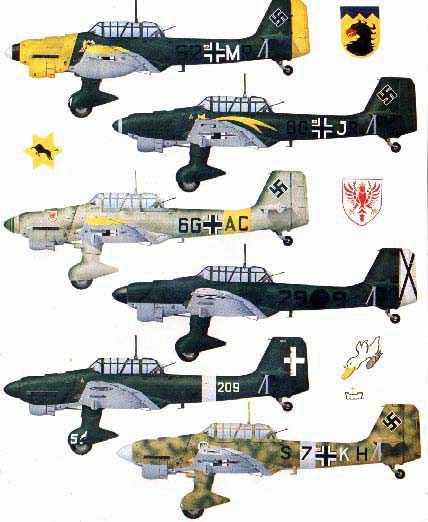
The United States and Germany, in particular, were enthusiastic proponents of the dive bomber during the later 1930s and the early part of World War 2. This particular species of warplane seemed to be typified in the Ju 87, whose ugly lines and wailing engine struck an especial note of terror in the skies above Poland, France and the Low Countries in 1939-40. Design of the Ju 87, by Dipl-Ing Pohlmann, started in 1933, and the first prototype flew early in 1935. This was powered by a Rolls-Royce Kestrel engine and had rectangular twin fins and rudders, but the Ju 87V2, flown in the following autumn, had a single tail and a 6 1 Ohp Junkers Jurno 2 1 OA engine, and was more representative of the production aircraft to follow.
A pre-series batch of Ju 87A-Os was started in 1936, and in the spring of 1937 delivery began of the Ju 87A- I initial production model, followed by the generally similar A-2. About two hundred A series were built before, in the autumn of 1938, there appeared the much-modified Ju 87B. Powered by the Jumo 211, this had an enlarged vertical tail, redesigned crew canopy and new-style cantilever fairing's over the main legs of the landing gear.
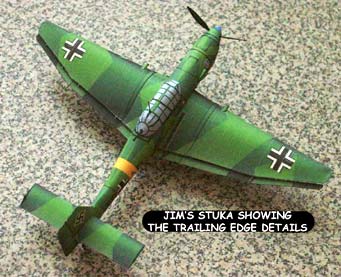 |
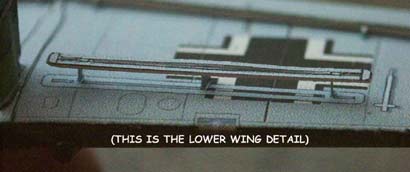 Dr. Jim Cookson sends in this photo showing how he detailed the Stuka wings... |
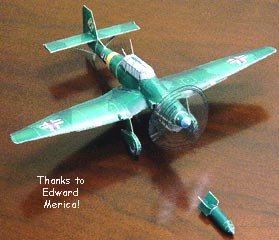 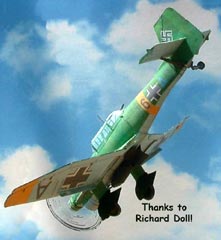
|
Both the A and B models were sent for service with the Condor Legion in Spain in 1938, but by the outbreak of World War 2 the A series had been relegated to the training role, and the three hundred and thirty-six aircraft in front-line service were all Ju 87B- Is. The fighter superiority of the Luftwaffe ensured the Ju 87 a comparatively uninterrupted passage in 1939-40, but opposition during the Battle of Britain was much sterner, and losses of the Ju 87 were considerably heavier. Nevertheless, production of the B series continued into 1941, and substantial numbers were supplied to the Regia Aeronautica, and to the air forces of Bulgaria, Hungary and Romania.
In production 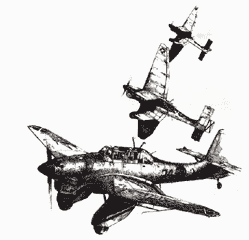 alongside the B series was the long-range
Ju 87R, which from 1940 was used for anti shipping and other missions.
Before the war small numbers were also completed of the Ju 87C,
a version of the B with arrester hook, folding wings and other
'navalized' attributes. This was planned for service aboard the
carrier Graf Zeppe1in, but the ship was never completed, and the
few Ju 87C-Os built served with a land-based unit. Others laid
down as C-Is were completed as B-2s. After the setbacks in the
Battle of Britain the Ju 87B continued to serve in the Mediterranean
and North Africa.
alongside the B series was the long-range
Ju 87R, which from 1940 was used for anti shipping and other missions.
Before the war small numbers were also completed of the Ju 87C,
a version of the B with arrester hook, folding wings and other
'navalized' attributes. This was planned for service aboard the
carrier Graf Zeppe1in, but the ship was never completed, and the
few Ju 87C-Os built served with a land-based unit. Others laid
down as C-Is were completed as B-2s. After the setbacks in the
Battle of Britain the Ju 87B continued to serve in the Mediterranean
and North Africa.
Its subsequent development and employment was mainly in the close-support role or as a trainer. Next major variant was the Ju 87D, whose evolution had begun in 1940. Several sub-types of this model were built, their chief characteristics being the use of a more powerful jumo engine, increased fuel tankage similar to that of the ju 87R, and a considerably refined airframe with reinforced armament and extra armour protection for the crew. Most D variants were evolved for a ground-attack role, and could carry a variety of different weapon loads ranging from a single 3,9681b bomb beneath the fuselage to a pair of under wing pods each containing six 7 - 9mm machine guns. The dive brakes fitted to the earlier ju 87s were usually omitted.
The ju 87D-5 introduced an extended wing of 49ft 21, in span, and the D-7 was a specialized night-attack version.
Variants of the Ju 87D served in the Mediterranean, North Africa
and on the Eastern Front, equipping units of the Hungarian and
Romanian air forces as well as those of the Luftwaffe. Proposals
to replace the D model by developments of it designated ju 87F
and ju 187 were abandoned in 1943, but one other variant was encountered
operationally. This was the ju 87G, which entered service in 1943
as an anti-tank aeroplane with a 37mm BK 3.7 cannon mounted in
a streamlined fairing attached beneath each wing. These could
be replaced by bombs for more general ground-attack missions.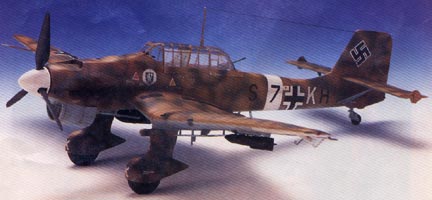
The Ju 87G was essentially a conversion of the long-span D-5, and aircraft of this type were quite successful in knocking out Soviet tanks along the Eastern Front until the appearance of better-class Soviet fighter opposition in the autumn of 1944. Operational trainers for pilots engaged in ground-attack work were produced, under the designation ju 87H, by converting various D sub-series to have dual controls and modified cockpit hoods. When production of the Ju 87 series finally ended in September 1944, more than five thousand seven hundred of these aircraft had been built.
The Ju 87G-1 anti-tank aircraft
..was the last variant of the Ju 87 to become operational, apart from the Ju 87H trainer. The G-11 was not a new-build variant, but was converted from Ju 87113-5 airframes. The basic Ju 87D-5 was adapted to carry a pair of massive Flak 18 (BK 3,7) 37-mm cannon pods under its outer wing panels. It could carry bombs instead of guns, but had no dive-brakes. The removal of dive bombing equipment made ~the G-11 most unrepresentative among Stuka variants. The concept was the brainchild of the extraordinary Hans-Ulrich Rudel who, despite being shot down 30 times, flew no fewer than 2,530 combat sorties and destroyed 519 Russian tanks. 10 (Pz)./SG3 formed in MarGh 1944 through the re designation of 4./StG2, and was based at Jakobstadt in Latvia as part of Luftflotte I between April and July 1944. The unit helped cover the retreat westwards, becoming incorporated in I/SG 9 as 2. Staffell on January 7, 1945, and ending the war in the Courliand pocket.
Where the Stuka Units served:
Unit Ju 87s took part in the Polish campaign, the attacks on the Low Countries and the Battle of France. The Stuka's then faced the fighters of the RAF in the Battle of Britain, and suffered accordingly. Another successful campaign in Greece and the Balkans followed, before the Stukegeschwader turned their attentions to the Eastern Front, where they fought until late 1943, when the units were redesignated as Schlachtgeschwader, most later transitioning to the more potent Fw 190. The Ju 87G-I s served only with l I I/SG 2 and with 10. (Pz)/SG 1, 10.(Pz)/SG 2, 10.(Pz)/SG 3, and 10 (Pz)/SG 77. Luftwaffe tactical aircraft carried four-digit/letter codes on the rear fuselage. The first pair denoted the major unit (Geschwader or Gruppe), the third identified the individual aircraft and was presented in differing colors depending on whether the unit was the staff flight, first, second or third Staffel of each group, and the fourth identified the Staffel itself.
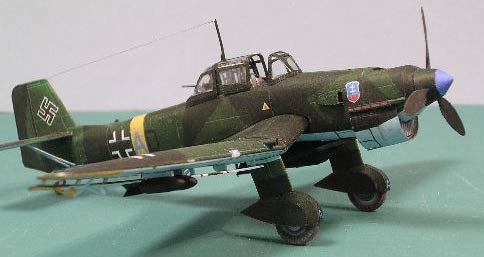 |
|
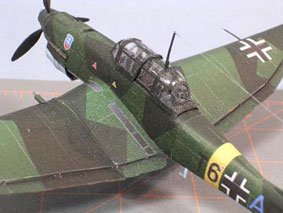 |
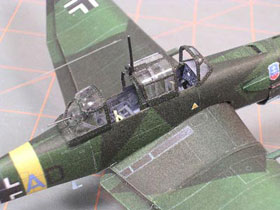 |
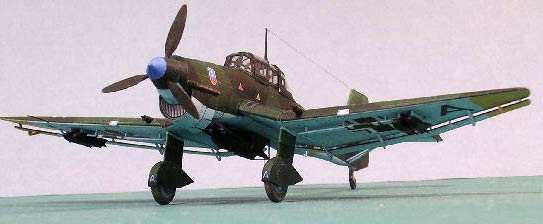 This is about as good as card modeling gets! Thanks to Dr John Glessner |
|
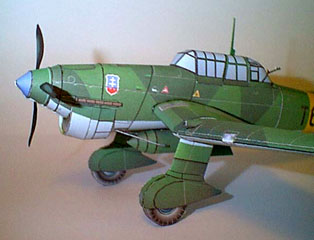 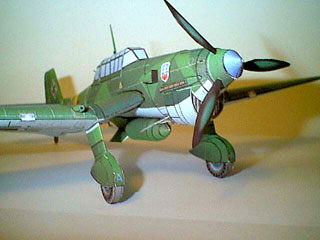 This is the final beta model that Chauncy built |
Answer: Ethan, I'll try to help: Start with the center section. Once assembled and dry, attach the out wing sections to it. Remember to leave the back edge of the gray center area open (that will be inside the fuselage) if you need to get fingers or tweezers in to help align the parts. Before cutting out the parts, very lightly score the line between the wing part and it's connecting tabs. Then when ready to assemble, pre-bend the tab into the approximate angle that will give the necessary "crook" to the wing(s). If you score these too deeply you're wings will flex and this is not desirable. Be very careful when gluing the wing assembly by paying special attention to the alignments of one part to another. Apply glue to a set of tabs and start by sliding the overlapping part onto them, slowing working your way down the seam until it is complete. Pay VERY close attention as you slide the parts together. Once a tab is covered and proper alignment is achieved at that point, move on to the next, etc. If the seams are all aligned correctly, the proper "crook" will have been attained. Actually, this will happen to several tabs at once as you move along. If, after completing the whole wing assembly you find that you still need more crank in the wings, grasp the wing assembly on either side of each outer joint and ever-so-slightly bend upwards. Too much, and the wings will buckle, so be very gentle and stop at the first sign of creasing. Do the port side and then starboard. Again, if one observes part alignment very carefully, this shouldn't be necessary. Chauncy Green
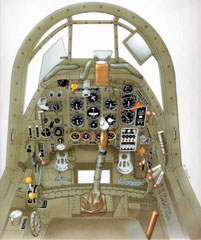 |
Junkers Ju 87 Cockpit. |
Specifications
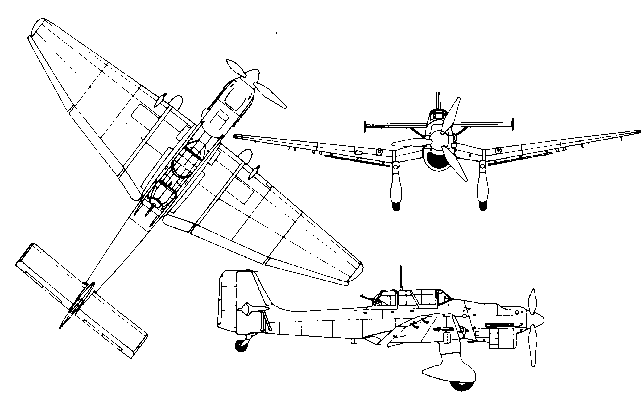 |
Crew: 2 Length: 36 ft 1.07 in Wingspan: 45 ft 3.30 in Height: 13 ft 10.53 in Wing area: 343.37 ft² Empty weight: 7,086 lb Loaded weight: 9,524 lb Max takeoff weight: 11,023 lb Powerplant: 1× Junkers Jumo 211D liquid-cooled inverted-vee V12 engine, 1184 hp Propellers: Three-blade Junkers VS 5 propeller, 1 per engine Propeller diameter: 11 ft 1.85 in Performance Never exceed speed: 373 mph Maximum speed: 242 mph @ 13,410 ft Range: 311 mi with 1,102 lb bomb load Service ceiling: 26,903 ft with 1,102 lb bomb load Armament Guns: 2× 7.92 mm (.312 in) MG 17 m achine gun forward, 1× 7.92 mm (.312 in) MG 15 machine gun to rear Bombs: Normal load = 1× 551 lb bomb beneath the fuselage and 2× 110 lb bombs underneath each wing. |
 |
 |
I've attached some photos of Stukas in winter camouflage to show modelers what thet might do with the B/W versions of the card models. Jason |
|
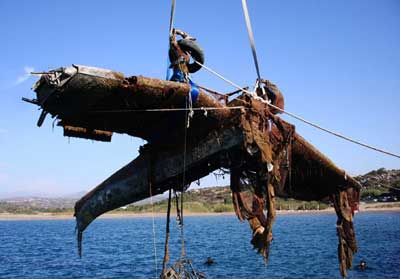 |
This Junkers Ju87 was shot down on October 9, 1943, when the II / St.G (Stuka Geschwader), based in Maritsa, lost nine Ju-87D-3/Through fire from the ships in the Royal Navy. Seven of them were sunk at sea and two made an emergency landing on land. |



